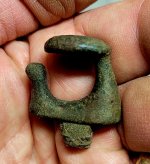somehiker
Silver Member
- May 1, 2007
- 4,365
- 6,426
- Primary Interest:
- All Treasure Hunting
Wayne,
All true but those with much more knowledge and understanding, than I, of Aztec history have labeled them "nomadic". Personally, I feel the name fits what happened over the 200 or so years while they migrated. As I stated, they all started out as nomads.
It's an interesting topic to discuss, especially with someone as knowledgeable as yourself, and FEMF.
Take care,
Joe
Joe:
Rather than adopt your understanding of "nomadic",I prefer to stay with the narrower definition as cited in this article.
This only because I do not believe the mass of people who,around 1015 CE began the journey which ended on the island in Lake Texcoco in 1325 CE,fit the category as I understand it.
Nomad - Wikipedia, the free encyclopedia
Where used properly,the "nomadic" label may very well fit those who became the "proto-Aztecs",according to M.E.Smith's hypothesis.
In his paper,titled "The Aztlan Migrations of the Nahuatl Chronicles: Myth or History?",Smith categorizes those arriving and taking up residence in the Valley of Mexico circa 500 CE.as "nomads" which become in turn,"proto-aztecs".
These are the Chichimec/Toltec groups of the "Chichimec migration theme",rather than the later group who's own journey began in the place they called "Aztlan",with the "seven caves of Chicmoztoc".
Michael E. Smith's article,published in 1984, is available here:
http://www.public.asu.edu/~mesmith9/1-CompleteSet/MES-84-Aztlan.pdf
Much of Smith's theory,although now dated,is what I have long held to be probable.
Despite claims by some to the contrary,the "science" is never settled.
And the history of the Americas as we ,amateurs and professionals both know it, is far from being completely written or debated by both Archaeologists and folks like us.While it may be necessary to possess a PHD in order to teach at university,we do not need as much in order to study and learn.
Many of the ideas and observations I have made within this and other related topics of online discussion over the years,are mirrored by the theories presented in these two lectures by Dr. Steven Lekson and DR.Carrol Riley.
Both presentations are well worth watching in their entirety.
Dr. Lekson's observations regarding Quetzalcoatl are of particular interest to me,especially with regard to my photo of the "image" on the canyon wall which we have discussed previously.
That the mobility of people through travel and trade would not have allowed the isolated development of either population group,SouthWestern US or MezoAmerican ,seems clear to me,as does the possibility that at least some of the people of the mass migration of the Mexica from Aztlan in 1015 could have been those who abandoned the Hohokam cities around 1000 CE.
That possibility is why I suggested that the Hohokam may have played a part in the rise of the Aztec Empire.
First,by forming the bulk of the group that joined in the southward exodus,and secondly by becoming one of the major Aztec trade partners while both cultures were in ascendency.
Regards:Wayne
Last edited:



